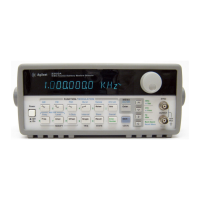BM:STATe {OFF|ON}
Disable or enable burst modulation. To ensure proper operation, you
should enable the burst mode after you have set up the other modulation
parameters. Only one modulation mode can be enabled at a time. When
you enable the burst mode, the previous modulation mode is turned off.
BM:STATe?
Query the state of burst modulation. Returns “0” (
OFF) or “1” (ON).
TRIGger:SOURce {IMMediate|EXTernal|BUS}
Select the burst “trigger” source. In the triggered burst mode, the
function generator outputs a waveform with the specified number of
cycles (burst count) each time a trigger is received. After the specified
number of cycles has been output, the function generator waits for the
next trigger while outputting no signal (zero volts or the dc offset level).
The default is IMM. [ Stored in volatile memory ]
In the triggered burst mode, the “burst source” is Internal.
When the Immediate (internal) trigger source is selected, the
frequency at which the burst is generated is determined by the
burst rate (BM:INT:RATE). The APPLy command automatically sets
the trigger source to IMMediate.
When the External trigger source is selected, the function generator
will accept a hardware trigger applied to the rear-panel Ext Trig
terminal. The function generator outputs the specified number of
cycles each time Ext Trig receives the rising edge of a
TTL pulse.
The
Trig annunciator turns on when the function generator is waiting
for an external trigger.
When the Bus (software) source is selected, the function generator
outputs one burst each time a bus trigger command is received.
To trigger the function generator from the remote interface (
GPIB or
RS-232), send the *TRG (trigger) command. You can also trigger the
function generator from the GPIB interface by sending the IEEE-488
Group Execute Trigger (GET) message (e.g., TRIGGER 710).
When the External or Bus trigger source is selected, the burst count
and burst phase remain in effect but the burst rate is ignored.
4
Chapter 4 Remote Interface Reference
Burst Modulation Commands
165

